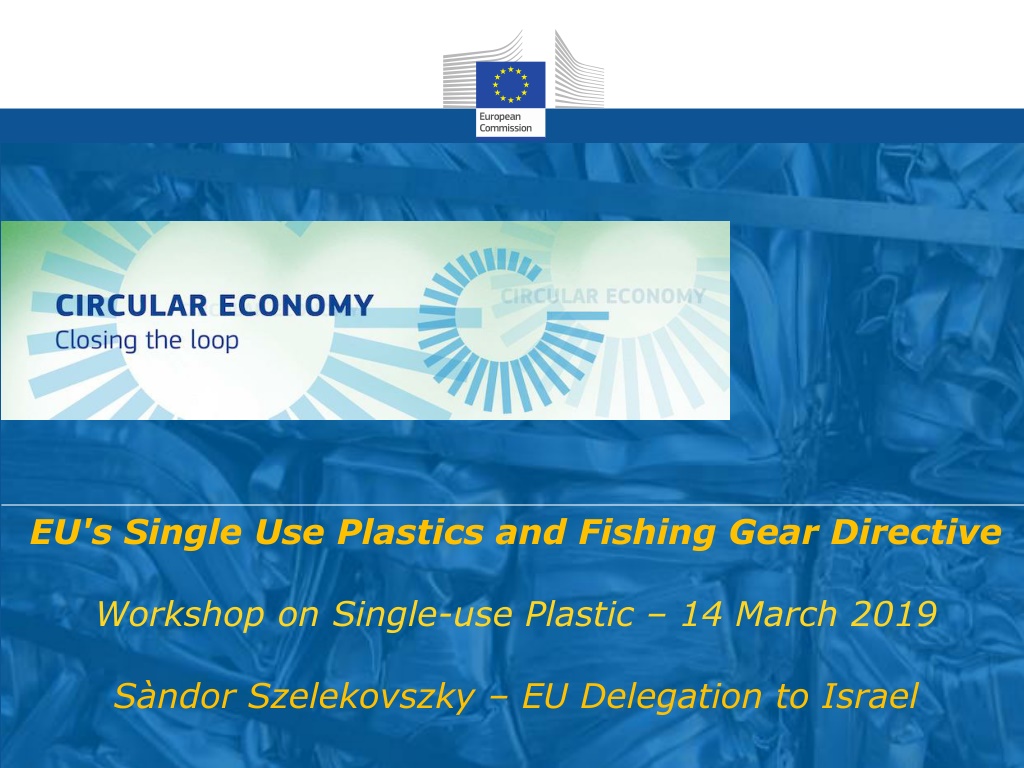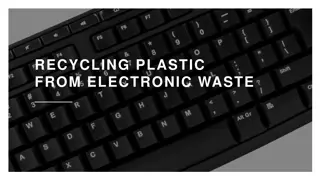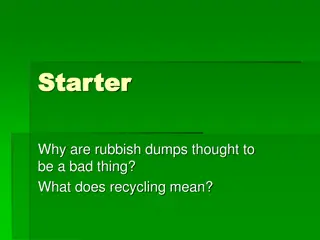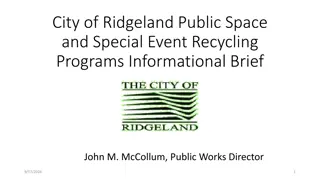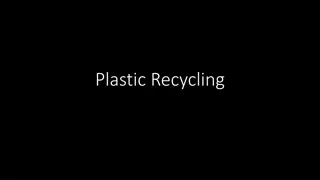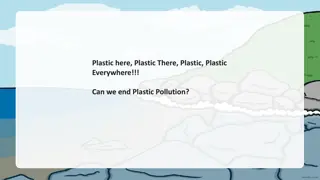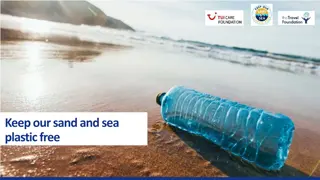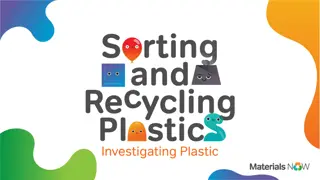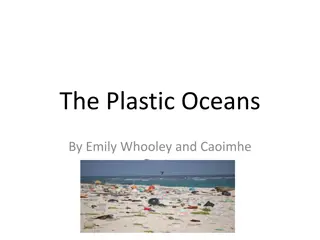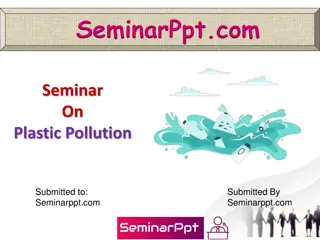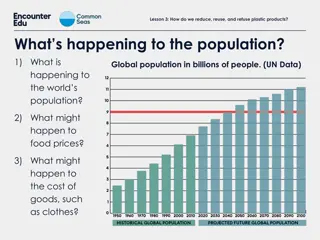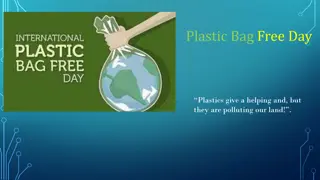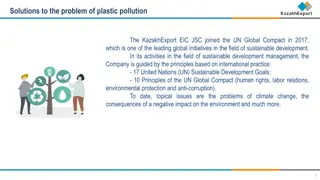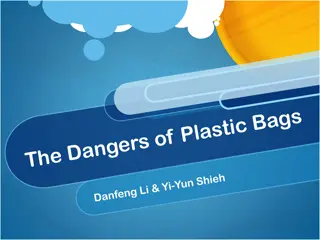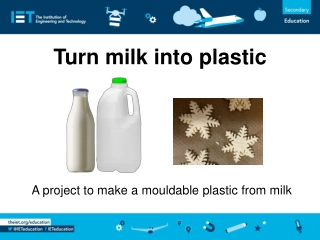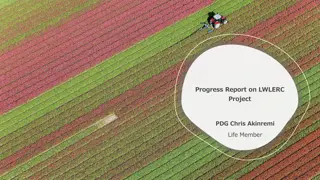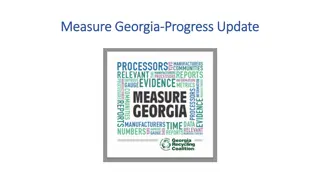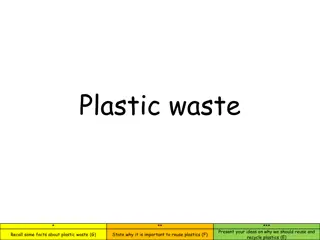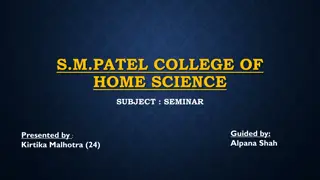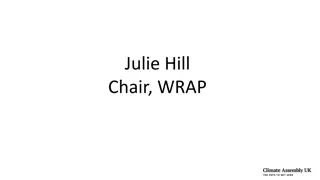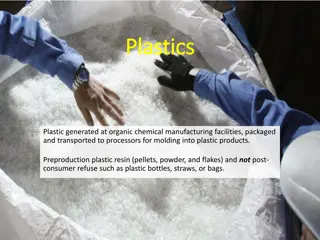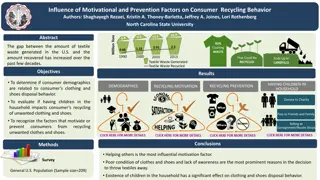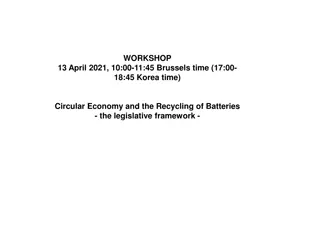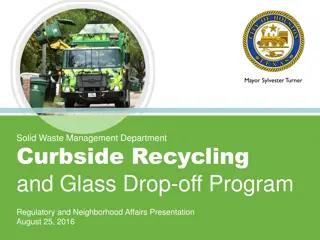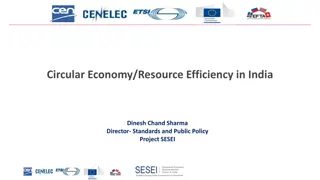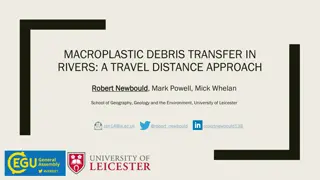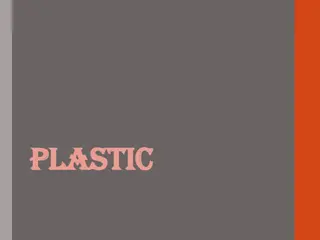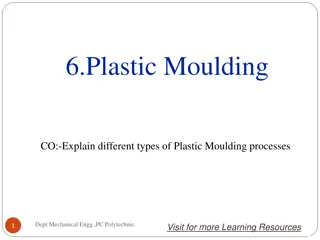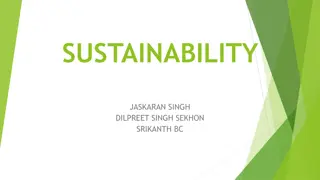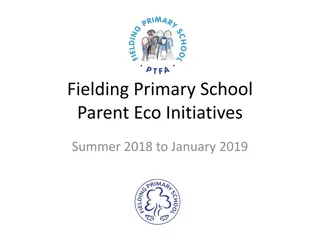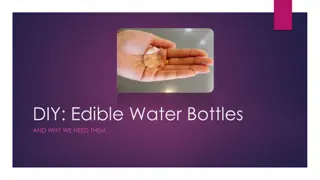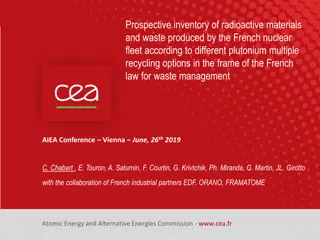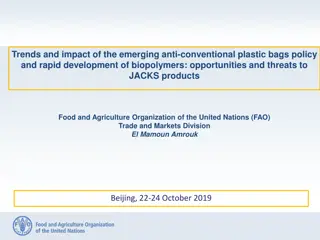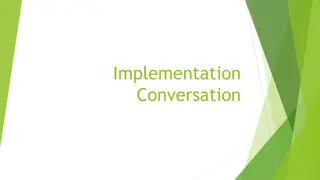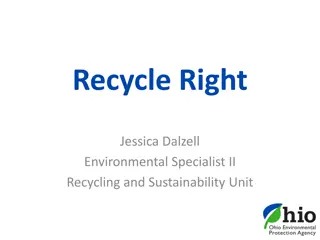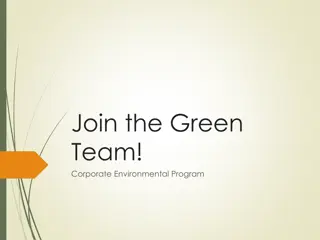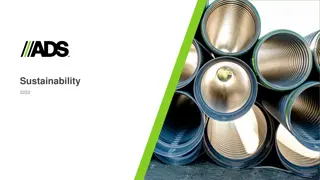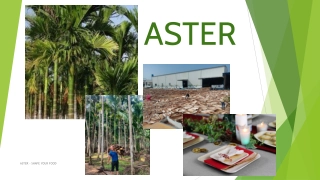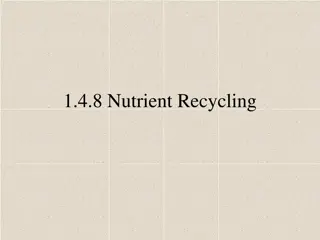EU Initiatives Towards Sustainable Plastic Use and Recycling
The European Union has implemented directives and strategies to reduce marine litter and promote a circular economy, focusing on single-use plastics, fishing gear, and plastic waste management. These initiatives aim to boost competitiveness, create jobs, drive innovation, and curb environmental risks associated with plastic use. Key measures include making recycling profitable, curbing plastic waste, stopping littering, and promoting investment in recyclable plastics. The EU's efforts seek to set a positive example for global sustainability solutions.
Download Presentation

Please find below an Image/Link to download the presentation.
The content on the website is provided AS IS for your information and personal use only. It may not be sold, licensed, or shared on other websites without obtaining consent from the author. Download presentation by click this link. If you encounter any issues during the download, it is possible that the publisher has removed the file from their server.
E N D
Presentation Transcript
EU's Single Use Plastics and Fishing Gear Directive Workshop on Single-use Plastic 14 March 2019 S ndor Szelekovszky EU Delegation to Israel
EU' Circular Economy Package The Package adopted on 2 December 2015 timing is not an incident Positive and clear signal to partners but also for investors Europe is the best place to environmentally-friendly business Aims: transition towards a circular economy to boost global competitiveness, foster sustainable generate new jobs and to enhance more innovative ways of producing and consuming "It's the economy, stupid" grow a sustainable and economic growth and
EU's Plastic Strategy adopted by European Commision in January 2018 Transforming the way products are designed, produced, used and recycled in the EU, through: Making recycling profitable for business (e.g. by means of new packaging rules, creating demand for recycled plastic etc.) Curb plastic waste (e.g. rules on single-use plastic etc.) Stop littering at the sea (e.g. rules on port facilities) Drive investment and innovation (e.g. recyclable plastic) Spur change across the world we need partners for global solutions
Implementation of the Plastics Strategy: Reducing Marine Litter Action on intentionally added micro-plastics Referred to the European Chemical Agency for possible restriction in the Framework of REACH. ECHA has published its restriction dossier stating that health and environmental risks posed by intentionally added micro-plastics justify an EU-wide restriction. ECHA s Scientific Committees will now review the dossier and an EU-wide restriction could be in place by mid-2020. Revision of the Port Reception Facilities Directive Includes measures to ensure that waste generated on ships or gathered at sea is returned to land and adequately managed. We reached political agreement in December 2018. Waste Framework Directive, as amended in 2018 Requires Member States to take measures aimed at halting the generation of marine litter and measures to prevent, reduce and clean-up litter, as well as to identify products that are the main sources of marine litter. Directive on Single Use Plastics and Fishing Gear Political agreement reached in December 2018. EP end March. Council adoption mid-April. Implementation within two years.
Why this Directive? Why this Focus? Other plastics 7% SUP top 10 items 86% SUP 50% Fishing related 27% Non-plastic 16% Remaining SUP items 14% 70% covered of all marine litter: top 10 SUP (43%) + fishing gear (27%)
10 most found items Ranking Item 1 Drinks bottles, caps and lids 2 Cigarette butts 3 Cotton buds sticks 4 Crisp packets / sweet wrappers 5 Sanitary applications 6 Plastic bags 7 Cutlery, straws and stirrers 8 Drinks cups and cup lids 9 Balloons and balloon sticks 10 Food containers including fast food packaging
The Directive will ensure the reduction of the impact of certain plastic products on the environment items with available sustainable alternatives promote less harmful alternatives: market bans prevention measures: design requirements, consumption reduction, consumer information items with no clear alternatives better waste management: separate collection, extended producer responsibility + clean-up
Consumption reduction (Article 4) Ambitious and sustainedreduction of plastic food containers and cups (including covers and lids). National marketing restrictions for products with options to substitute. Food containers Cups for beverages Member States choose the appropriate measures Consumption reduction targets Economic instruments Increase the availability of alternatives e.g. re-usable Items not provided free of charge
Market restriction - bans (Article 5) Market restrictions or bans on products with readily available alternatives (both single & multi use): Cotton bud sticks Cutlery Plates Straws Beverage stirrers Sticks for balloons
Product design requirements (Article 6) Tethered caps and lids for all beverage containers and bottles up to 3 litres (5 years after the entry into force of the Directive) Binding target of at least 25% of recycled plastic for beverage bottles by 2025 As of 2030, all single use plastic bottles will have to respect a target of at least 30% of recycled content.
Marking Requirements (Article 7) For tobacco products with filters, cups for beverages, wet wipes and sanitary towels clear and harmonized labelling will be required. For cups, the label will be on the product itself. The label will indicate how waste should be disposed, the presence of plastics in the product and the resulting negative environmental impact.
Extended producer responsibility (Article 8) For plastic products such as food and beverage containers, bottles, cups, packets and wrappers, light weight carrier bags and tobacco products with filters producers will have to contribute to the costs of: - waste prevention (awareness raising) - waste management (collection and treatment costs of waste in public areas) - litter clean-up - data gathering. For wet wipes and balloons, only the waste prevention and litter clean-up costs should be covered.
Provisions on Fishing gear o Extended schemes to cover the costs of separate collection and further treatment of waste from fishing gear o Member States will set a national collection targets and monitor fishing gear waste with a view to a later EU-wide collection target o Work on harmonized standards for the circular design of fishing gear. Producer Responsibility (EPR)
Separate collection (Article 9) Separate collection target for plastic beverage bottles to be achieved through EPR or through deposit refund schemes by 2025 77% by 2029 90% Supporting high quality recyclates and uptake of secondary raw materials Supporting plastic packaging recycling target of 55% by 2030
Next steps: Evaluation of the Directive after 6 years (Article 15) To enhance further efforts and to draw on experiences in implementation regular monitoring comprehensive Review will take place, including: and in addition a Reporting implementation by the European Commission on Reviewing the list of SUPs in the Annex Setting quantitative consumption reduction targets for food containers and beverage cups Establishing binding collection rates for fishing gear
(Next steps 2) Evaluation of biodegradability Assessment of the scientific and technical progress concerning criteria for biodegradability in the marine environment applicable to single-use plastic products within the scope of this directive and their single-use substitutes This is key to evaluate the efficiency of the measures taken and to recalibrate action.
Impacts & costs Reduction of plastics littering > 50% reduction of plastics littering from top 10 SUP items Avoid CO2 emissions Eq. 3.4 mn tonnes Avoid environmental damage Eq. of 23 bn benefit Savings for consumers 6.5 bn Jobs creation 30 000 Waste management costs 0.8 bn Cost for business: compliance, commercial washing multi-use items & refill schemes 2.4 bn
Implementation of the Plastics Strategy - Pledging Campaign The Commission received so far over 60 pledges from plastics recyclers, industry associations and brand owners mainly for PET packaging. It is estimated that at least 10 million tons of recycled plastics could be supplied by 2025 if the pledges are fully delivered. However the demand side (utilizers) only pledged for 6.5 million tons more targeted action will be needed on this end to promote the up-take of recycled plastic.
Circular Plastics Alliance The aim of the Circular Plastics Alliance, is to improve the economics and quality of plastics recycling in Europe. The Alliance will in particular strengthen the match between supply and demand for recycled plastics which is identified as a key obstacle to a well-functioning EU market of recycled plastics. The Circular Plastics Alliance will help achieving the target of at least 10 million tons of recycled plastics finding their way into new products on the EU market by 2025 as set in the European Strategy for Plastics. In the course of 2019 the Alliance will come up with Roadmap on implementation. The Alliance will also monitor the delivery of the pledges and set up a common monitoring system.
Circular Plastic Alliance (2) - The Alliance was launched in December 2018 with key industry stakeholders covering the full plastic value chain to reduce litter and to increase the share if recycled plastic This Platform is to encourage cooperation and dialogue between market operators both on supply and demand side covering waste collectors, primary producers, converters, brand owners and retailers in particular in packaging, construction and automotive sectors Main operational objectives: - Fostering coordinated actions and investments by stakeholders - Reporting on obstacles which may hamper efforts - Monitoring progress made and identifying gaps. - - - - -
Few Preliminary Conclusions - The overall Strategic Framework is best to start with - Clear rules on individual sectors (plastic, construction/energy) should follow to mobilize targeted efforts - Create economically attractive conditions is essential - But regulatory pressure on operators is equally important - Creating a comprehensive platforms ("Alliance") for stakeholders - Reaching out, informing the wider public also necessary - International cooperation sine qua non condition - The EU is ready to further engage!
Learn more about this Directive, the plastics strategy and the circular economy: http://ec.europa.eu/environment/circular-economy/index_en.htm
